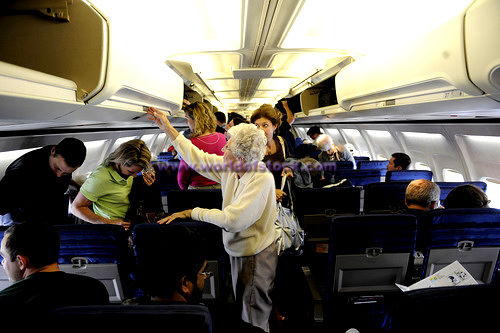There is a surprising amount of research out there on the effectiveness of different plane-boarding processes — and, honestly, a surprising amount of videos on YouTube of literally nothing more than people waiting to board a plane. I suppose it all makes sense, though: flying is a crucial component of many people’s lives, whether for business or to go see family/friends, and the process of boarding makes absolutely no sense. You stand around to wait to be called (wait No. 1), then wait in the jet-bridge (wait No. 2), then wait in the aisle of the plane (No. 3), then wait in your seat as it taxis (No. 4). There is no FAA-standard approach to boarding a flight, so most airlines use “back-to-front.” Unfortunately, that’s the slowest method out there. Actually, a totally random boarding process is faster than back-to-front.
The stat in the headline of this post comes from research that Boeing did on the matter; read that here. It all begs the question: can we get better at this? It makes sense that security lines are long — that’s what some will grouse about, but still deem a necessary evil in most respects — but can we up-tick the wait at the gate?
There are some ideas/approaches. American Airlines spent two years studying the flaws in the system and came up with a randomized approach for non-elite travelers. Here’s the thing to remember, though: even though it seems like every flight you’re on is oversold, airlines are still a rough business with small-arse margins. Airlines are always looking for ways to make extra money. They have no true desire to make the process any better, because as long as the process sucks, they can charge extra money for people who want to board earlier, or do something with their carry-on, or whatever it is. This is a little bit how something like Spirit works: horrible customer ratings, but good revenue stream (for an airline). They pack people into planes and they charge you for everything, not the least of which is, well, the ability to board sooner.
Jason Steffen is a stud in this space. Here’s a paper he wrote on the topic.
How does it work? Here’s the basic rundown:
He suggested boarding in alternate rows, window seats first, progressing from the rear forward: seats 12A, for example, followed by 10A, 8A and so on, then returning for 9A, 7A, 5A and so on, and then filling the middle and aisle seats in the same way.
The approach avoids a situation in which passengers are struggling to use the same physical space at the same time.
When they ran actual tests on this, back-to-front boarding took about seven minutes (smaller sample size than a normal plane). The Steffen Method took about half that time. Perhaps not surprisingly, no major airline has ever approached Steffen about his research or working with him (his real job involves the Kepler telescope, so he’s kind of a big deal).
Another popular approach is WILMA, or “Windows-Middles-Aisles,” which United switched to full-time in 2005. This supposedly shaves 2-3 minutes off the process in general; it saves time predominantly because it avoids aisle-seat passengers having to get unbelted to let others in, thus creating an additional back-up in the center aisle.
Finally, of course another huge problem is the idea of paying $25 for a checked bag. By instituting this at the gate, oftentimes it seems like airlines are throwing money at a problem — or rather, collecting money from a problem. The situation almost leads to every flight running out of overhead space, which invariably sends people deep in the plane — Row 27, etc. — to the front to tag their bag, which creates another 2-3 minutes you lost with WILMA. There needs to be something clearer around the idea of the carry-on, because the more people exploit that system (or agree to pay for it), the more crowded the bins become, and the more crowded the bins become, the longer the load time.
Is this something that will be solved tomorrow, or even in the next five years? Probably not. But it’s good to know there are people out there thinking about this from an effectiveness standpoint.
